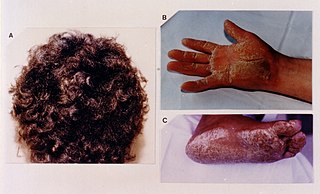Related Research Articles

Palmoplantar keratodermas are a heterogeneous group of disorders characterized by abnormal thickening of the stratum corneum of the palms and soles.

Keratoderma blennorrhagicum etymologically meaning keratinized (kerato-) skin (derma-) mucousy (blenno-) discharge (-rrhagia) are skin lesions commonly found on the palms and soles but which may spread to the scrotum, scalp and trunk. The lesions may resemble psoriasis.

Sézary disease, or Sézary syndrome, is a type of cutaneous T-cell lymphoma that was first described by Albert Sézary. The affected T cells, known as Sézary's cells or Lutzner cells, have pathological quantities of mucopolysaccharides. Sézary disease is sometimes considered a late stage of mycosis fungoides with lymphadenopathy.
Keratoderma is a hornlike skin condition.

Camisa disease is the variant form of Vohwinkel syndrome, characterized by ichthyosis and normal hearing.

Naxos disease is a cutaneous condition characterized by a palmoplantar keratoderma. The prevalence of the syndrome is up to 1 in every 1000 people in the Greek islands.

Corneodermatosseous syndrome is an autosomal dominant condition with onset in infancy, characterized by corneal dystrophy, photophobia, diffuse palmoplantar keratoderma, distal onycholysis, skeletal abnormalities, with brachydactyly, short stature, and medullary narrowing of digits.
Schöpf–Schulz–Passarge syndrome is an autosomal recessive condition with punctate symmetric palmoplantar keratoderma, with the keratoderma and fragility of the nails beginning around age 12. In addition to palmoplantar keratoderma, other symptoms include hypodontia, hypotrichosis, nail dystrophies, and eyelid cysts. Patients may also develop syringofibroadenoma and squamous cell carcinomas.
Keratoderma climactericum is a skin condition characterized by hyperkeratosis of the palms and soles beginning at about the time of menopause.
Howel–Evans syndrome is an extremely rare condition involving thickening of the skin in the palms of the hands and the soles of the feet (hyperkeratosis). This familial disease is associated with a high lifetime risk of esophageal cancer. For this reason, it is sometimes known as tylosis with oesophageal cancer (TOC).
Woolly hair nevus is a congenital condition in which hair in a circumscribed area of the scalp is kinked or woolly.
Drug-induced keratoderma is a cutaneous condition characterized by a hornlike skin texture.
Bart–Pumphrey syndrome is a cutaneous condition characterized by hyperkeratoses over the metacarpophalangeal, proximal and distal interphalangeal joints.
Hystrix-like ichthyosis–deafness syndrome is a cutaneous condition characterized by a keratoderma.
Craniosynostosis–anal anomalies–porokeratosis syndrome is a cutaneous condition inherited in an autosomal recessive fashion.
Keratosis linearis with ichthyosis congenita and sclerosing keratoderma syndrome is a rare cutaneous condition characterized by ichthyosis and keratoderma.
Hypotrichosis–acro-osteolysis–onychogryphosis–palmoplantar keratoderma–periodontitis syndrome is a cutaneous condition characterized by a prominent palmoplantar keratoderma.
References
- ↑ Rapini, Ronald P.; Bolognia, Jean L.; Jorizzo, Joseph L. (2007). Dermatology: 2-Volume Set. St. Louis: Mosby. ISBN 1-4160-2999-0.